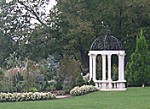 Ample rain, high humidity, and cloudy days with just a touch of sun now and then set the stage for this week’s garden. Many plants seem to thrive while others languish but so far most are doing well.
Ample rain, high humidity, and cloudy days with just a touch of sun now and then set the stage for this week’s garden. Many plants seem to thrive while others languish but so far most are doing well.
I saw quite a few mushrooms and I thought they were quite handsome. This guy was large, about 8’ across.
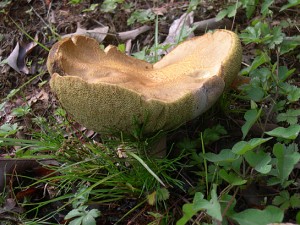
This one looks like it just popped out of the ground.
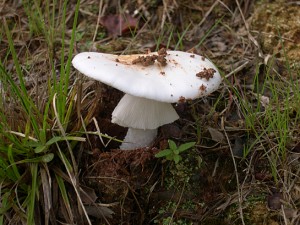
A fairy ring of ones like these made a pretty site.
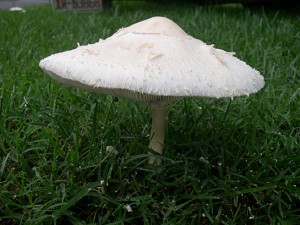
They look like this and are about 8” across when they are a day older.
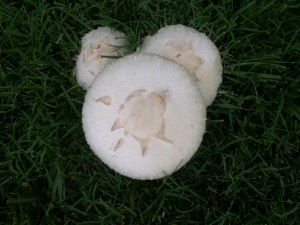
This Venus fly trap (Dionaea muscipula) in the bog garden loved the heat and humidity and graced us with flowers.
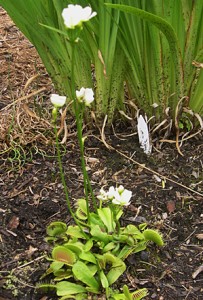
The rose Sobreuil found its way into the secret garden and is producing the second flush of full, fragrant, old fashioned flowers. Fringed bleeding heart (Dicentra exima) bloom below.
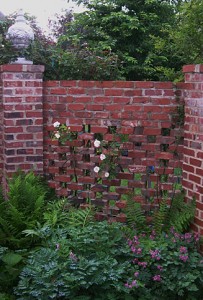
Nearby foamflower (Tiarella wherryi) continues to bloom while my garden fairy looks on. It has bloomed for over a month.
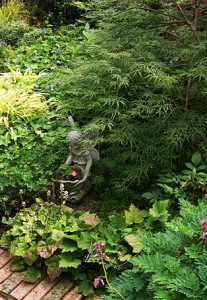
In another part of the secret garden, the clematis ‘Dr. Ruppel’ blooms on its own pillar.
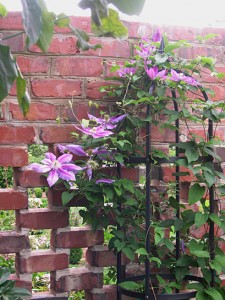
Chinses astilbe (A.chinensis) dominates one area with its spikes of pink and dense tuft of finely cut leaves. The purple folilage of Heuchera ‘Amethyst Mist’ looks lovely with the pink flowers of the astilbe.
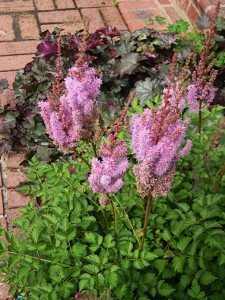
In the formal garden the borders are beginning to fill in. In the hot border the orange red Asiatic lilies ‘Gran Paradiso’ are made hotter by the orange butterfly weed (Asclepias tuberosa) next to it while blanket flowers (Garllardia x grandiflora ‘Goblin’) add yellow to the mix.
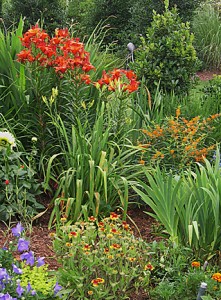
The pastel border is looking better everyday.
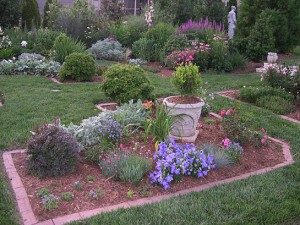
The pink balloon flowers (Platycodon grandiflora), lemon yellow threadleaf coreopsis (Coreopsis verticillata ‘Moonbean’) and blue annual flossflower (Ageratum houstonianum) form an accidental combination I like.
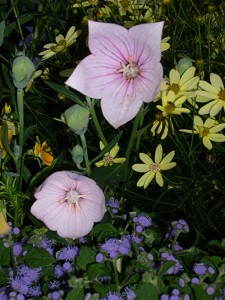
These lovely cream colored lilies (Lilium speciosum album) take my breathe away.
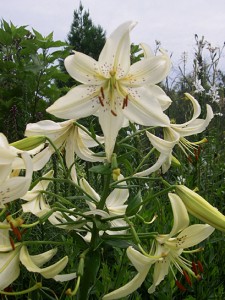
Crimson beebalm (Monarda didyma) and silver wormwood Artemisia x ‘Powis Castle’ are a nice combination. The beebalm is one of those plants I threatened with exile if it didn’t produce this year and this is the result.
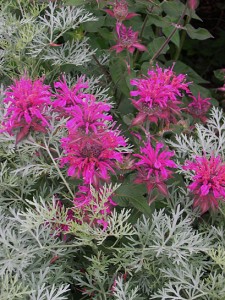
Pink coneflower (Echinacea purpurea ‘Magnus’) complements the pink of the rose ‘Lovely Fairy’ as they stand at the entrance to the formal garden.
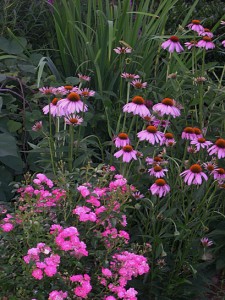
One parterre features this heavy textured day lily(Hemerocallis) that is almost white, but not quite.
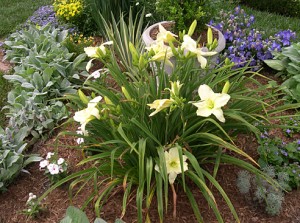
This peach colored hollyhock (Alcea rosea) give a nostalgic look to one corner of the border.
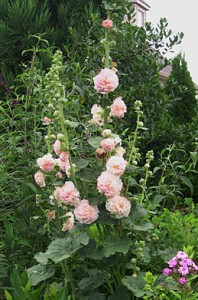
The flowers of the hollyhock are double and look like fluffy carnation.
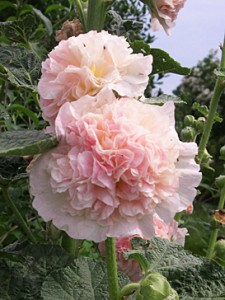
Stokes aster (Stokesia laevis ‘Blue Danube’) adds both fine texture and lavender blue color to the border.
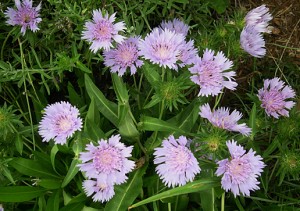
Gooseneck loosestrife (Lysimachia clethroides) never fails to entertain and amuse me. It is a garden thug but I forgive it for its gregarious nature.
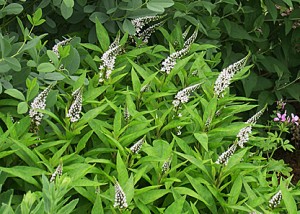
The bright green fine foliage of green Lavender Cotton (Santolina virens) is a perfect background for the small, lemon yellow button shaped flowers. I really grow it for the foliage so the flowers are a welcome bonus.
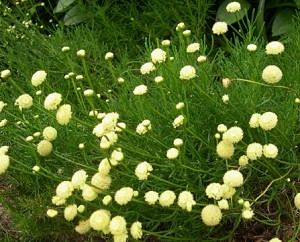
I also grow the silver gray Lavender Cotton (Santolina chamaecyparissus) but I don’t think the yellow flowers are attractive with the foliage. I could cut them off but I don’t because I enjoy them anyway.
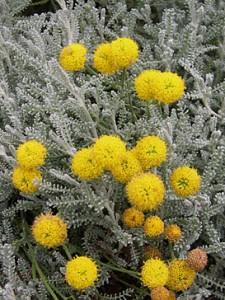
This sunflower is a surprise. It was a volunteer from the nearby bird feeder. Quite honestly the color of the coneflowers was a surprise too; I thought I had transplanted excess pink ones to this area. I am tempted to move them but I like the way they look with the variegated grasses and the blue-gray dune grass.
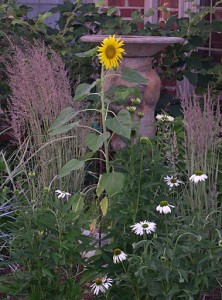
The bad news is that pests plague the rose garden. No, not the usual black spot or mildew, but Japanese beetles and deer. Here is what greets us everyday:
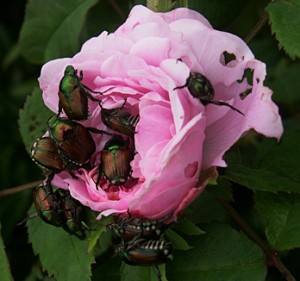
The beetles also like the leaves.
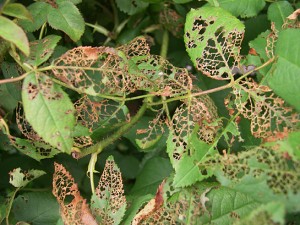
The chief gardener devised this beetle catcher and it works really well. It is a 1 gallon milk carton that has been cut down and filled with water and dish detergent. The large size of the opening facilitates shaking a large number of beetles into its depth and so is very effective.
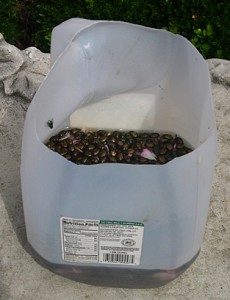
Deer are a terrible problem too. This very sad rose ‘Leomie Lamesh’ has been almost stripped of leaves as has many other plants near her. My research on this suggests that only a high fence will solve the problem but I decided to try cat urine and spreaded dirty kitty litter around the outside of the rose garden hedge. Who knows, it just may work.
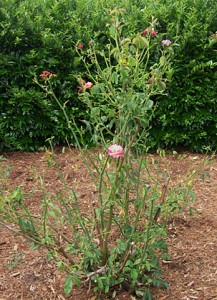
The deer and beetles are selective and do not touch some of the roses like this huge ‘Reine des Violettes’ who is putting forth her second bloom.
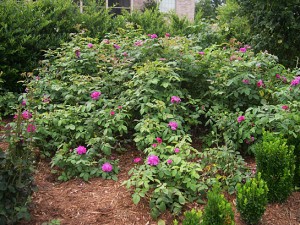
The good news is that the deer do not bother with our vegetables. We have lettuce galore and many succulent treats but they seem immune to the lures of such vulgarian fare. We know they visit the garden from the dropping they leave but nothing there is better than rose leaves. Darn…
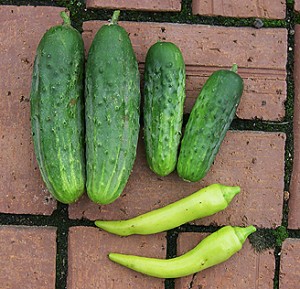
High heat and humidity is not all that bad. In fact it was a sort of blessing for newly planted seeds; those that were supposed to germinate in 7-10 days germinated in 4 and are growing vigorously. In view of the fact that I am late in planting these seeds I really lucked out. I think I will plant some more neglected seeds because you just never know. Try it; it might work out for you too.

|
|
|
|
|
||||||||||||||||||||||||||||||||||||||||||||||||||||||||||||||||||||||||||||||||||||||||||||||||||||||||||||||||||||||||||||||||||||||||||||||||||||||||||||||||||||||||||||||||||||||||||||||||||||||||||||||||||||||||||||||||
Funny that you mention the quick germination rate due to the weather. In the past two weeks, I found that it only took three days or less for my marigold, zinnia and cosmos seeds. Cosmos were the fastest! Jackie
I love your garden. I just started gardening a couple of years ago, but mostly vegetables garden.
Shame about the roses – by the looks of things you are suffering a beetle invasion!
Your garden is looking lovely. Strange that the deer don’t bother the vegetables – I would have thought they would be quite tempting 🙂
You beat me! I thought my 4 days was good but 3 days is definitely a lot better.
I hope that you will continue to garden and expand your interests. Perhaps you could send us some pictures.
I think we have very spoiled deer here. Our deer population outstripped the carrying capacity of its range quite a long time ago because people were so sympathetic to the story of Bambi and his mom that they would not allow hunting enough to control the deer population. I did a senior paper on this topic in college way back in 1962 in New York state and nothing has changed so the deer population throughout the Eastern seaboard has increased while their habitat has decreased. I really don’t know what the answer is. Do you have a deer population in England?
[…] Garden Journal: June 21 2009 […]
[…] Comments Garden Journal: June 21 2009 on Garden Journal: July 26, 2009Garden Journal: July 26, 2009 on Garden Journal May 31, 2009How to […]